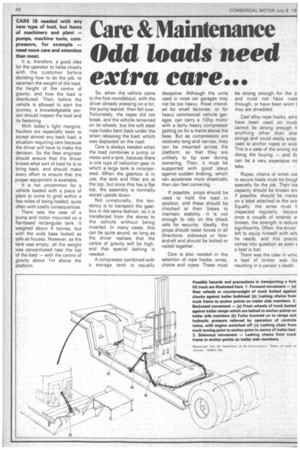Care & Maintenance
Page 50

If you've noticed an error in this article please click here to report it so we can fix it.
Odd loads need extra care...
CARE IS needed with any new type of load, but items of machinery and plant — pumps, machine tools, compressors, for example — need more care and attention than most.
It is, therefore, a good idea for the operator to liaise closely with the customer before deciding how to do the job, to ascertain the weight of the load, the height of the centre of gravity, and how the load is distributed. Then, before the vehicle is allowed to start the journey, a knowledgeable person should inspect the load and its fastening.
With today's light margins, hauliers are especially keen to accept almost any back load, a situation requiring care because the driver will have to make the decision. So the fleet engineer should ensure that the driver knows what sort of load he is to bring back, and should make every effort to ensure that the proper equipment is available.
It is not uncommon for a vehicle loaded with a piece of plant to come to grief within a few miles of being loaded, quite often with costly consequences.
There was the case of a pump and motor mounted on a flat-based rectangular tank. It weighed about 4 tonnes, but with the wide base looked as safe as houses. However, as the tank was empty, all the weight was concentrated near, the top of the load -with the centre of gravity about 1m above the platform. So, when the vehicle came to the first roundabout, with the driver already pressing on a bit, the pump leaned, then fell over. Fortunately, the ropes did not break, and the vehicle remained on its wheels, but the soft steel rope hooks bent back under the strain releasing the load, which was deposited on the road.
Care is always needed when the load combines a pump or motor and a tank, because there is one type of reduction gear in which a large tank is incorporated. When the gearbox is in use, the tank and filter are at the top, but since this has a flat top, the assembly is normally stored upside down.
Not unnaturally, the tendency is to transport the gearbox in the same fashion, as it is transferred from the stores to the vehicle without being inverted. In many cases, this can be quite sound, so long as the driver realises that the centre of gravity will be high, and that special lashing is needed.
A compressor combined with a storage tank is equally deceptive. Although the units used in most car garages may not be too heavy, those intended for small factories, or for heavy commercial vehicle garages, can carry a 10hp motor with a.fairly heavy compressor getting on for a metre above the base. But as compressors are relatively long and narrow, they can be mounted across the platform, so that they are unlikely to tip over during cornering. 'Then, it must be supported with good stays against sudden braking, which can accelerate more drastically than can fast cornering.
If possible, props should be used to hold the load in position, and these should be chocked at their bases to maintain stability. It is not enough to rely on the chock rails for security. Ideally, the props should resist forces in all directions, sideways or foreand-aft and should be bolted or nailed together.
Care is also needed in the selection of rope hooks, wires, chains and ropes. These must be strong enough for the jc and must not have rustE through, or have been worn t they are shredded.
Cast alloy rope hooks, whic have been used on truck cannot be strong enough fi anything other than shei strings and could easily snap used to anchor ropes or wire This is a case of the wrong me doing the buying -and th can be a very expensive mi take.
Ropes, chains or wires use to secure loads must be bougl specially for the job. Their loa capacity should be known an if possible, should be marke on a label attached to the win Equally, the wires must L inspected regularly, becau5 once a couple of strands al broken, the strength is reduce significantly. Often, the driver left to equip himself with whi he needs, and this practic comes into question as soon E a load is lost.
There was the case in whic a load of timber was los resulting in a person's death.




























































































